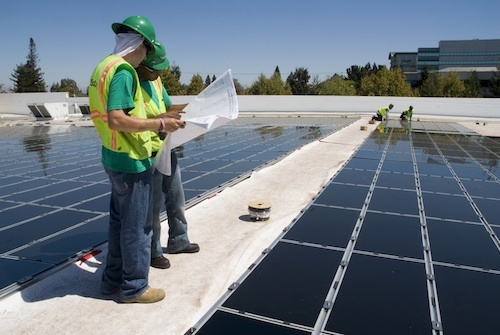INSTITUTE INDEX: Wal-Mart goes green?

Percent increase Wal-Mart plans for its renewable energy production or procurement by 2020, according to a recent announcement from the Arkansas-based retail giant: 600
Kilowatt-hours of renewable energy the company hopes to be producing and procuring by then: 7 billion
Number of U.S. fossil-fuel plants whose output would be offset by that level of energy savings: about 2
Number of solar projects Wal-Mart operates worldwide today: nearly 300
Number of renewable energy projects the company added in 2012 alone: nearly 100
Rank of Wal-Mart among U.S. companies for both solar capacity and number of solar systems installed: 1
Percent of Wal-Mart's electricity globally that's now supplied by renewables: 21
Amount in energy costs savings Wal-Mart expects to enjoy annually as a result of the transition to renewables: $1 billion
Metric tons of greenhouse gases Wal-Mart's renewables plan would prevent from being released into the environment: 9 million
Metric tons of greenhouse gases Wal-Mart* currently produces worldwide each year: 21.4 million
Metric tons by which Wal-Mart's greenhouse gas emissions exceed those of the 50 lowest-emitting countries combined: 6 million
Year in which Wal-Mart pledged to boost energy efficiency by 20 percent per unit produced at 200 Chinese factories: 2008
Number of years later that the Environmental Defense Fund, Wal-Mart's partner in the Chinese efficiency effort, quit the program over the company's lack of cooperation: 3
Size of bribe Wal-Mart's Mexico subsidiary paid to change a zoning map in order to build a store near the ancient pyramids of Teotihuacán, a cultural landmark: $52,000
Amount the company paid in bribes to build a Sam's Club in one of Mexico City's most densely populated neighborhoods, without an environmental permit or other required licenses: $341,000
Amount it paid in bribes to build an enormous refrigerated distribution center in an environmentally fragile flood basin north of Mexico City: $765,000
Since Wal-Mart began expanding in the 1970s, percent by which the number of miles logged per household for shopping has grown: over 300
Typical percent sales decline suffered by local supermarkets and other stores when a Wal-Mart opens: 10 to 40
According to a 2009 study, factor by which revenue given back to communities by locally owned businesses exceeds that of stores like Wal-Mart: 2
Year in which Wal-Mart landed on Global Exchange's list of 10 "Most Wanted" human rights violators for problems including low pay, abuse of workers, and racial discrimination: 2012
* Including emissions related to powering Wal-Mart stores, distribution centers, company offices, and corporate jets, but not including emissions related to its supply chain, a global web of more than 100,000 companies.
(Click on figure to go to source.)
Tags
Sue Sturgis
Sue is the former editorial director of Facing South and the Institute for Southern Studies.
